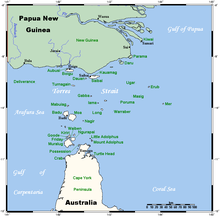 | |
| Total population | |
|---|---|
| 66,387[1] | |
| Regions with significant populations | |
| Torres Strait Islands 4,514[2] | |
| Australia (mainland) | 61,873 |
| Languages | |
| Torres Strait Island languages, Torres Strait Creole, Torres Strait English, Australian English | |
| Religion | |
| Christianity | |
| Related ethnic groups | |
| Melanesians | |
Note difficulties with census counts.[2] | |
Torres Strait Islanders (/ˈtɒrɪs/ TORR-iss)[3] are the Indigenous Melanesian people of the Torres Strait Islands, which are part of the state of Queensland, Australia. Ethnically distinct from the Aboriginal peoples of the rest of Australia, they are often grouped with them as Indigenous Australians. Today, many more Torres Strait Islander people live in mainland Australia (nearly 28,000) than on the Islands (about 4,500).
Five distinct peoples exist within the broader designation of Torres Strait Islander people, based partly on geographical and cultural divisions. Kalaw Lagaw Ya and Meriam Mir comrpise the two main Indigenous language groups; Torres Strait Creole is also widely spoken as a language of trade and commerce. The core of Island culture is Papuo-Austronesian, and the people are traditionally a seafaring nation. The Torres Islanders exhibit a strong artistic culture, particularly in sculpture, printmaking, and mask-making.
- ^ Cite error: The named reference
2016censuswas invoked but never defined (see the help page). - ^ a b "3238.0.55.001 – Estimates of Aboriginal and Torres Strait Islander Australians, June 2016". Australian Bureau of Statistics. 31 August 2018. Retrieved 27 December 2019.
- ^ "Torres Strait. Oxford Dictionary Online". Oxford University Press. Archived from the original on 23 August 2018. Retrieved 23 August 2018.